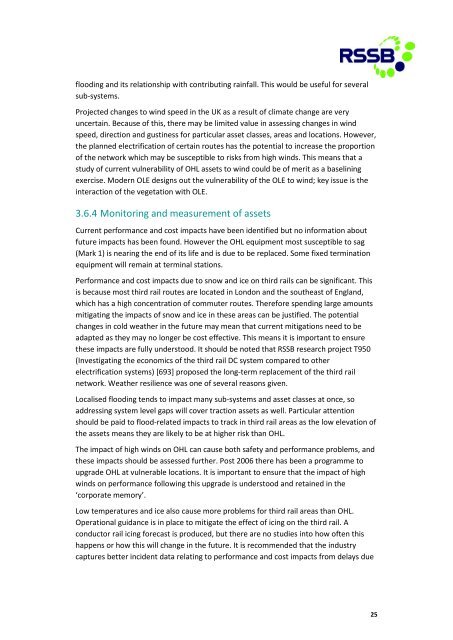Tomorrow's Railway and Climate Change Adaptation Final Report
2016-05-T1009-final-report
2016-05-T1009-final-report
Create successful ePaper yourself
Turn your PDF publications into a flip-book with our unique Google optimized e-Paper software.
flooding <strong>and</strong> its relationship with contributing rainfall. This would be useful for several<br />
sub-systems.<br />
Projected changes to wind speed in the UK as a result of climate change are very<br />
uncertain. Because of this, there may be limited value in assessing changes in wind<br />
speed, direction <strong>and</strong> gustiness for particular asset classes, areas <strong>and</strong> locations. However,<br />
the planned electrification of certain routes has the potential to increase the proportion<br />
of the network which may be susceptible to risks from high winds. This means that a<br />
study of current vulnerability of OHL assets to wind could be of merit as a baselining<br />
exercise. Modern OLE designs out the vulnerability of the OLE to wind; key issue is the<br />
interaction of the vegetation with OLE.<br />
3.6.4 Monitoring <strong>and</strong> measurement of assets<br />
Current performance <strong>and</strong> cost impacts have been identified but no information about<br />
future impacts has been found. However the OHL equipment most susceptible to sag<br />
(Mark 1) is nearing the end of its life <strong>and</strong> is due to be replaced. Some fixed termination<br />
equipment will remain at terminal stations.<br />
Performance <strong>and</strong> cost impacts due to snow <strong>and</strong> ice on third rails can be significant. This<br />
is because most third rail routes are located in London <strong>and</strong> the southeast of Engl<strong>and</strong>,<br />
which has a high concentration of commuter routes. Therefore spending large amounts<br />
mitigating the impacts of snow <strong>and</strong> ice in these areas can be justified. The potential<br />
changes in cold weather in the future may mean that current mitigations need to be<br />
adapted as they may no longer be cost effective. This means it is important to ensure<br />
these impacts are fully understood. It should be noted that RSSB research project T950<br />
(Investigating the economics of the third rail DC system compared to other<br />
electrification systems) [693] proposed the long-term replacement of the third rail<br />
network. Weather resilience was one of several reasons given.<br />
Localised flooding tends to impact many sub-systems <strong>and</strong> asset classes at once, so<br />
addressing system level gaps will cover traction assets as well. Particular attention<br />
should be paid to flood-related impacts to track in third rail areas as the low elevation of<br />
the assets means they are likely to be at higher risk than OHL.<br />
The impact of high winds on OHL can cause both safety <strong>and</strong> performance problems, <strong>and</strong><br />
these impacts should be assessed further. Post 2006 there has been a programme to<br />
upgrade OHL at vulnerable locations. It is important to ensure that the impact of high<br />
winds on performance following this upgrade is understood <strong>and</strong> retained in the<br />
‘corporate memory’.<br />
Low temperatures <strong>and</strong> ice also cause more problems for third rail areas than OHL.<br />
Operational guidance is in place to mitigate the effect of icing on the third rail. A<br />
conductor rail icing forecast is produced, but there are no studies into how often this<br />
happens or how this will change in the future. It is recommended that the industry<br />
captures better incident data relating to performance <strong>and</strong> cost impacts from delays due<br />
25


